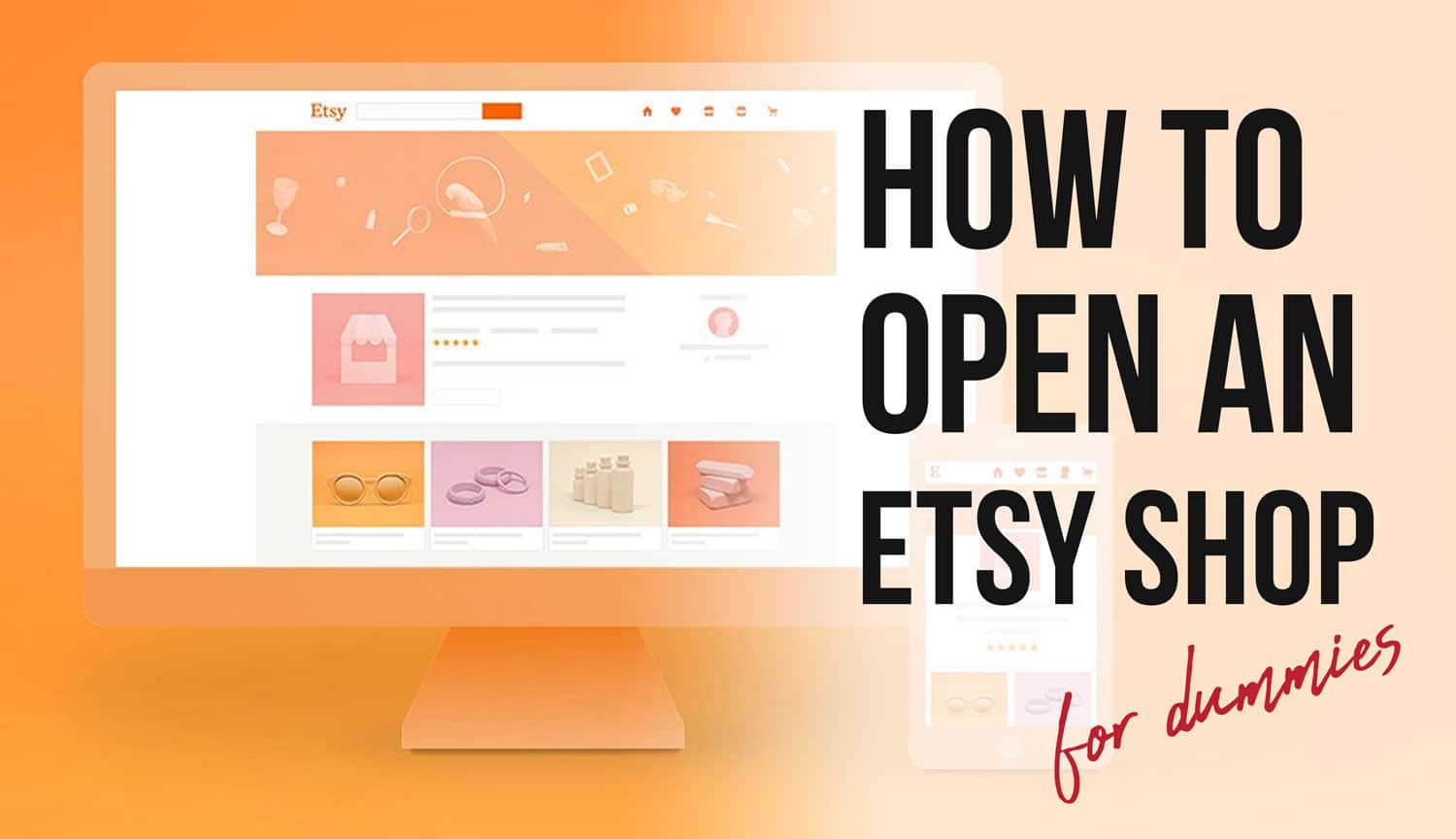You’ve got your business name, logo and product labels and products, now it’s time to start selling! Most people don’t start out selling through their own website for multiple reasons including cost, time investment, lack of technical know-how, and lack of brand awareness to drive traffic. The best way to start out selling is to go with an established platform that already has a huge amount of traffic of people looking to buy from and support small businesses. This article is a step-by-step guide about how to open an Etsy shop!
Create Your Etsy Shop
So let’s get started. First thing’s first, you need to have an Etsy account if you don’t already have one, which is straightforward enough.
Next is setting up your shop’s language, home country and currency and then you’ll enter your shop’s name, which has to be between 4 and 20 characters long and can’t be the same as another pre-existing business, so keep that in mind.
Product Listings
Next is creating your product listings! You’ll need photos, preferably several for each item you’re selling (up to 10). Try to have multiple angles, and especially if the product is a skin care product within a jar, you’ll want to include lid-off photos to show off the actual product. If possible, try to show the product being used or interacted with in one of the images. Also, make sure your images are sharp, square, and larger than 1000px. Quick note: Natural daylight makes the best photos, especially when it’s diffused and soft. You’ll want to pick your best image for your product thumbnail, because first impressions are key.
The listing details are the next step, make sure to add a straightforward title that gives a succinct but thorough idea of the product and keep under the 140 character limit. Add a detailed description of the product you are selling, including ingredients and any disclaimers if applicable as well as any other information that you think will help sell it further, or that the customer needs to be aware of before purchasing. Make sure you use as many keywords as possible that are relevant to your product to help with your shop’s SEO (Search Engine Optimization) and help your shop get discovered more easily.
Choose your product category and type and add tags. Tags are important as they are one of the ways your product can be discovered and you’re limited to only 13 of them, so pick them carefully while keeping in mind what customers might search for to get to your item.
Next is the pricing, sales tax info if applicable, quantity, variations (for example if you offer different scents for a body butter), and the shipping details. Shipping details include choosing services, costs, country of origin, processing time/handling time, item weight and size.
Lastly, after double checking EVERYTHING, it’s time to publish your Etsy shop!
Payment Preferences
After you’ve published your items, you’ll choose how you want to receive your payments, either PayPal, check or money order, or Etsy Payments. With Etsy Payments, you can accept credit + debit cards, Etsy gift cards, and store credit. Etsy requires Etsy Payments as an accepted method, depending on your location, which you’ll need to provide an address and bank account in order to setup.
Billing
Next is setting up billing so Etsy can charge you for your listings. Depending on your country, Etsy will require you provide a credit card for identity purposes, which isn’t a big deal since you have to have a card on file anyway so they can charge it for selling fees. If you’re in the US, you can enroll in auto-billing, so you’ll just be charged automatically for selling fees as they happen.
Joining Etsy and creating a shop are free, but actually listing things costs money, so take that into account when pricing your products. Etsy charges you (in US dollars) $0.20/listing which is for a four month time period. You can set listings to auto-renew so when the listing expires, you will get charged again. On top of the listing fee, Etsy charges a 5% transaction fee (including shipping) when something sells AND if you use Etsy Payments, you’ll incur a processing fee for that as well. That fee is dependent on your location, but for US based sellers, it’s 3% + $0.25 per transaction.
There are other fees for additional Etsy services such as making an in-person sale using Square, running ads, and shipping labels.
These fees can add up, so make sure you price your products accordingly, do your research on other shops selling products, make sure your pricing is competitive, but that your prices cover your time, materials, labor and other production costs. Helpful information from Etsy can be found here.
Another quick tip about finances is if possible keep your personal and business finances separate. Get a business credit card and use that for all your business costs to better help you keep track of expenses, especially when it comes to tax time.
Further Shop Customization
Now is the point where your shop is technically ready to go, but you’ll really want to customize it to sell your brand/business further.
You’ll want to add a bio and photo, so you can tell your potential customers about yourself and your business. You can talk about how and why you started the business, your mission and really anything you’d like. People love to feel connected to the products they are purchasing and the business they are buying from.
Additionally you’ll want to add a header image for your shop. Choose something that will grab attention, but also displays what your business sells. Also, including your logo in/on the image is always a good call. Branding, branding, branding!
In addition to the shop owner’s bio section, you’ll also want to fill out the shop’s About section. The character limit here is 5000 characters, so feel free to be thorough. Tell about your business’s origin story, share photos/videos of your business/products, including behind the scenes stuff. Again, buyers want to feel connected to your business and love when companies are transparent about their practices.
A quality of life improvement for your shop is making sure you have sections on your shop page so customers can quickly filter to the products they are interested in and also feel free to rearrange the items on your page to suit you. If your products are all lumped together and there doesn’t seem to be rhyme nor reason to the organization, your store will come across as sloppy and potentially unappealing. You want things looking sharp and organized.
Policies
You’ll want to have your policies ironed out, including how you make your products, processing/handling times, shipping and payment options. Buyers will want to be able to find answers to all their possible questions before making a purchase, and if the information isn’t readily available, they might not bother with sending you a message to ask, but rather move on from your shop, costing you a potential customer.
Social Media Tools
One of the main ways people advertise now is through social media. Etsy has a built in tool that allows you to push updates to your social media networks (after linking the accounts). These updates can include store milestones, new products, reviews, and store announcements.
Other Notes
Sales on Etsy don’t necessarily happen immediately, or even after a few months, but the more listings you have, the more likely it is that your products will be seen and potentially purchased. Keep in touch with your customers, if you get a message with a question, respond as quickly as possible and don’t be afraid to ask for feedback. You’ll need to provide excellent customer service in order to get 5-star reviews which is a huge help in getting more sales.
As a final note, Etsy has a huge Seller’s Handbook as a resource full of great, in-depth information for sellers on their platform, so definitely check it out for more in-depth information.
Hope this post helps you get your foot in the door on Etsy, so get out there, open a shop and start selling!




